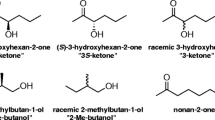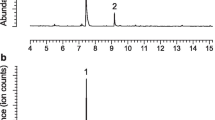Abstract
Research over the last decade has revealed extensive parsimony among pheromones within the large insect family Cerambycidae, with males of many species producing the same, or very similar aggregation pheromones. Among some species in the subfamily Cerambycinae, interspecific attraction is minimized by temporal segregation, and/or by minor pheromone components that synergize attraction of conspecifics or inhibit attraction of heterospecifics. Less is known about pheromone-based mechanisms of reproductive isolation among species in the largest subfamily, the Lamiinae. Here, we present evidence that the pheromone systems of two sympatric lamiine species consist of synergistic blends of enantiomers of (E)-6,10-dimethyl-5,9-undecadien-2-ol (fuscumol) and the structurally related (E)-6,10-dimethyl-5,9-undecadien-2-yl acetate (fuscumol acetate), as a mechanism by which species-specific blends of pheromone components can minimize interspecific attraction. Male Astylidius parvus (LeConte) were found to produce (R)- and (S)-fuscumol + (R)-fuscumol acetate + geranylacetone, whereas males of Lepturges angulatus (LeConte) produced (R)- and (S)-fuscumol acetate + geranylacetone. Field experiments confirmed that adult beetles were attracted only by their species-specific blend of the enantiomers of fuscumol and fuscumol acetate, respectively, and not to the individual enantiomers. Because other lamiine species are known to produce single enantiomers or blends of enantiomers of fuscumol and/or fuscumol acetate, synergism between enantiomers, or inhibition by enantiomers, may be a widespread mechanism for forming species-specific pheromone blends in this subfamily.






Similar content being viewed by others
References
Bense U (1995) Longhorn beetles: illustrated key to the Cerambycidae and Vesperidae of Europe. Margraf, Weikersheim, Germany
Borden JH, Chong L, McLean JA, Slessor KN, Mori K (1976) Gnathotrichus sulcatus: synergistic response to enantiomers of the aggregation pheromone sulcatol. Science 192:894–896
Bordon JH, Handley JR, McLean JA, Silverstein RM, Chong L, Slessor KN, Johnston BD, Schuler HR (1980) Enantiomer-based specificity in pheromone communication by two sympatric Gnathotrichus species (Coleoptera: Scolytidae). J Chem Ecol 6:445–456
Byrne KJ, Swigar AA, Silverstein RM, Borden JH, Stokkink E (1974) Sulcatol: population aggregation pheromone in the scolytid beetle, Gnathotrichus sulcatus. J Insect Physiol 20:1895–1900
Elliot AC, Hynan LS (2011) A SAS® macro implementation of a multiple comparison post hoc test for a Kruskal-Wallis analysis. Comput Methods Prog Biomed 102:75–80
Fonseca MG, Vidal DM, Zarbin PHG (2010) Male-produced sex pheromone of the cerambycid beetle Hedypathes betulinus: chemical identification and biological activity. J Chem Ecol 36:1132–1139
Graham EE, Mitchell RF, Reagel PF, Barbour JD, Millar JG, Hanks LM (2010) Treating panel traps with a fluoropolymer enhances their efficiency in capturing cerambycid beetles. J Econ Entomol 103:641–647
Handley K, Hough-Goldstein J, Hanks LM, Millar JG, D'Amico V (2015) Diversity and phenology of cerambycid beetles in urban forest fragments of northern Delaware. Ann Entomol Soc Am 108:251–262
Hanks LM, Millar JG (2013) Field bioassays of cerambycid pheromones reveal widespread parsimony of pheromone structures, enhancement by host plant volatiles, and antagonism by components from heterospecifics. Chemoecology 23:21–44
Hanks LM, Wang Q (2017) Reproductive biology of cerambycid beetles. In: Wang Q (ed) Cerambycidae of the world: biology and management. CRC Press/Taylor & Francis, Boca Raton (in press)
Hanks LM, Millar JG, Moreira JA, Barbour JD, Lacey ES, McElfresh JS, Reuter FR, Ray AM (2007) Using generic pheromone lures to expedite identification of aggregation pheromones for the cerambycid beetles Xylotrechus nauticus, Phymatodes lecontei, and Neoclytus modestus modestus. J Chem Ecol 33:889–907
Hanks LM, Millar JG, Mongold-Diers JA, Wong JCH, Meier LR, Reagel PF, Mitchell RF (2012) Using blends of cerambycid beetle pheromones and host plant volatiles to simultaneously attract a diversity of cerambycid species. Can J For Res 42:1050–1059
Hanks LM, Reagel PF, Mitchell RF, Wong JCH, Meier LR, Silliman CA, Graham EE, Striman BL, Robinson KP, Mongold-Diers JA, Millar JG (2014) Seasonal phenology of the cerambycid beetles of east-Central Illinois. Ann Entomol Soc Am 107:211–226
Hansen L, Tian X, Wickham J, Hanks LM, Millar JG, Teale SA (2015) Identification of a male-produced pheromone component of the citrus longhorned beetle, Anoplophora chinensis. PLoS One 10:e0134358
Hayes R, Griffiths MW, Nahrung HF, Arnold PA, Hanks LM, Millar JG (2016) Optimizing generic cerambycid pheromone lures for Australian biosecurity and biodiversity monitoring. J Econ Entomol. doi:10.1093/jee/tow100
Hughes GP, Zou Y, Millar JG, Ginzel MD (2013) (S)-Fuscumol and (S)-fuscumol acetate produced by a male Astyleiopus variegatus (Coleoptera: Cerambycidae). Can Entomol 145:1–6
Hughes GP, Meier LR, Zou Y, Millar JG, Hanks LM, Ginzel MD (2016) Stereochemistry of fuscumol and fuscumol acetate influences attraction of longhorned beetles of the subfamily Lamiinae. Environ Entomol 45:1271–1275
Liendo-Barandiaran CV, Herrara B, Morillo F, Sánchez P, Hernández JV (2010) Identification of male sexual pheromone in Steirastoma breve (Coleoptera: Cerambycidae). Abstract, First Latin-American Meeting of Chemical Ecology, Colonia del Sacramento, Uruguay, 17–20 Oct 2010, p O-7
Linsley EG (1959) The ecology of the Cerambycidae. Annu Rev Entomol 4:99–138
Linsley EG, Chemsak JA (1995) The Cerambycidae of North America, part VII, no. 2: taxonomy and classification of the subfamily Lamiinae, tribes Acanthocinini through Hemilophini. Univ Calif Publ Entomol 114:1–292
Millar JG, Hanks LM (2017) Chemical ecology of cerambycid beetles. In: Wang Q (ed) Cerambycidae of the world: biology and pest management. CRC Press/Taylor & Francis, Boca Raton (in press)
Millar JG, Pierce HD Jr, Pierce AM, Oehlschlager AC, Borden JH (1985) Aggregation pheromones of the grain beetle, Cryptolestes turcicus (Coleoptera: Cucujidae). J Chem Ecol 11:1071–1081
Millar JG, Hanks LM, Moreira JA, Barbour JD, Lacey ES (2009) Pheromone chemistry of cerambycid beetles. In: Nakamuta K, Millar JG (eds) Chemical ecology of wood-boring insects. Forestry and Forest Products Research Institute, Ibaraki, Japan, pp. 52–79
Miller DR, Borden JH, Slessor KN (1996) Enantiospecific pheromone production and response profiles for populations of pine engraver, Ips pini (say) (Coleoptera: Scolytidae), in British Columbia. J Chem Ecol 22:2157–2172
Mitchell RF, Graham EE, Wong JCH, Reagel PF, Striman BL, Hughes GP, Paschen MA, Ginzel MD, Millar JG, Hanks LM (2011) Fuscumol and fuscumol acetate are general attractants for many species of cerambycid beetles in the subfamily Lamiinae. Entomol Exp Appl 141:71–77
Mitchell RF, Millar JG, Hanks LM (2013) Blends of (R)-3-hydroxyhexan-2-one and alkan-2-ones identified as potential pheromones produced by three species of cerambycid beetles. Chemoecology 23:121–127
Mitchell RF, Reagel PF, Wong JCH, Meier LR, Silva WD, Mongold-Diers J, Millar JG, Hanks LM (2015) Cerambycid beetle species with similar pheromones are segregated by phenology and minor pheromone components. J Chem Ecol 41:431–440
Monné MA, Hovore FT (2005) Checklist of the Cerambycidae (Coleoptera) of the western hemisphere. BioQuip, Rancho Dominguez
Mori K (2007) Significance of chirality in pheromone science. Bioorg Med Chem 15:7505–7523
Narai Y, Zou Y, Nakamuta K, Mongold-Diers JA, Hanks LM, Millar JG (2015) Candidate aggregation pheromones of two potentially invasive Asian cerambycid species in the genus Xylotrechus. J Econ Entomol 108:1444–1446
Oehlschlager AC, King GGS, Pierce HD Jr, Pierce AM, Slessor KN, Millar JG, Borden JH (1987) Chirality of macrolide pheromones of grain beetles in the genera Oryzaephilus and Cryptolestes and its implications for species specificity. J Chem Ecol 13:1543–1554
SAS Institute (2011) SAS/STAT 9.3 user's guide. SAS Institute Inc., Cary NC, USA
Silk PJ, Sweeney JD, Wu J, Price J, Gutowski JM, Kettela EG (2007) Evidence for a male-produced pheromone in Tetropium fuscum (F.) and Tetropium cinnamopterum (Kirby) (Coleoptera: Cerambycidae). Naturwissenschaften 94:697–701
Slessor KN, King GGS, Miller DR, Winston ML, Cutforth TL (1985) Determination of chirality of alcohol or latent alcohol semiochemicals in individual insects. J Chem Ecol 11:1659–1667
Sokal RR, Rohlf FJ (1995) Biometry, 3rd edn. WH Freeman and Co, New York
Švácha P, Lawrence JF (2014) Chapter 2.4 Cerambycidae Latreille, 1802, pp. 77–177. In: Leschen RAB, Beutel RG (eds) Handbook of zoology: Arthropoda: Insecta: Coleoptera, beetles. Vol. 3: Morphology and systematics (Phytophaga), Walter de Gruyter, Berlin/Boston
Sweeney JD, Silk PJ, Gutowski JM, Wu J, Lemay MA, Mayo PD, Magee DI (2010) Effect of chirality, release rate, and host volatiles on response of Tetropium fuscum (F.), Tetropium cinnamopterum Kirby, and Tetropium castaneum (L.) to the aggregation pheromone, fuscumol. J Chem Ecol 36:1309–1321
Sweeney JD, Silk PJ, Grebennikov V (2014) Efficacy of semiochemical-baited traps for detection of longhorn beetles (Coleoptera: Cerambycidae) in the Russian far east. Eur J Entomol 111:397–406
Vidal DM, Fonseca MG, Zarbin PH (2010) Enantioselective synthesis and absolute configuration of the sex pheromone of Hedypathes betulinus (Coleoptera: Cerambycidae). Tetrahedron Lett 51:6704–6706
Wickham JD, Harrison RD, Lu W, Guo Z, Millar JG, Hanks LM, Chen Y (2014) Generic lures attract cerambycid beetles in a tropical montane rain forest in southern China. J Econ Entomol 107:259–267
Zar J (2010) Biostatistical analysis, 5th edn. Pearson Prentice-Hall, Upper Saddle River
Zarbin PHG, Fonseca MG, Szczerbowski D, Oliveira ARM (2013) Biosynthesis and site of production of sex pheromone components of the cerambycid beetle, Hedypathes betulinus. J Chem Ecol 39:358–363
Zhang A, Oliver JE, Aldrich JR, Wang B, Mastro VC (2002) Stimulatory beetle volatiles for the Asian longhorned beetle, Anoplophora glabripennis (Motschulsky). Z Naturforsch 57c:553–558
Zou Y, Rutledge CE, Nakamuta K, Maier CT, Hanks LM, Richards AB, Lacey ES, Millar JG (2016) Identification of a pheromone component and a critical synergist for the invasive beetle Callidiellum rufipenne (Coleoptera: Cerambycidae). Environ Entomol 45:216–222
Acknowledgments
We thank S. buck and the University of Illinois Committee on Natural Area for access to field sites. We appreciate funding support from The Alphawood Foundation of Chicago (to LMH), and the USDA National Institute of Food and Agriculture (grant number 2012-67013-19303, to JGM and LMH).
Author information
Authors and Affiliations
Corresponding author
Additional information
An erratum to this article is available at http://dx.doi.org/10.1007/s10886-016-0796-6.
Rights and permissions
About this article
Cite this article
Meier, L.R., Zou, Y., Millar, J.G. et al. Synergism between Enantiomers Creates Species-Specific Pheromone Blends and Minimizes Cross-Attraction for Two Species of Cerambycid Beetles. J Chem Ecol 42, 1181–1192 (2016). https://doi.org/10.1007/s10886-016-0782-z
Received:
Revised:
Accepted:
Published:
Issue Date:
DOI: https://doi.org/10.1007/s10886-016-0782-z




